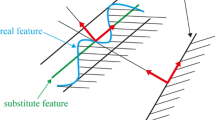Abstract
In this paper, a general methodology to do tolerance analysis of rigid assemblies is proposed. Firstly, tolerance specification sets, according to GD&T or ISO specifications, are translated into variational features by using 4 × 4 homogenous transformation matrices. In particular, planar and cylindrical features are considered. Then, once all variational features are modeled, assembly constraints among parts are introduced. To solve assembly constraints, an assembly transformation matrix is evaluated. By using point, line, and plane entities and their combinations, kinematic joints are modeled. A numerical procedure is proposed to solve fully and over-constrained assemblies. The best-fit alignment among variational mating features is performed by using optimization algorithms. The proposed method for tolerance analysis of rigid part assemblies allows to simulate different assembly sequences. Finally, in order to show the effectiveness of the proposed methodology, three case studies are described and analyzed.
Similar content being viewed by others
References
Whitney DE (2004) Mechanical assemblies, their design, manufacture, and role in product development. Oxford University Press, New York. ISBN 0-19-515782-6
Kim JS, Kim KM, Lee J, Jung HB (2004) Solving 3D geometric constraints for closed-loop assemblies. Int J Adv Manuf Technol 23:755–761
Kim JS, Kim KM, Choi K, Lee J (2005) Solving 3D geometric constraints for assembly modelling. Int J Adv Manuf Technol 16:843–849
Kim JS, Kim KM, Lee J, Jeong J (2005) Generation of assembly models from kinematic constraints. Int J Adv Manuf Technol 26:131–137
Turner JU, Subramaniam S, Gupta S (1992) Constraint representation and reduction in assembly modelling and analysis. IEEE Trans Robot Autom 8:741–750
Tanaka F, Murai M, Kishinami T, Tokunaga H (2001) Constraint reduction based on a lie algebra for kinematic analysis of assembly. Proceedings of 2001 IEEE International Symposium on Assembly and task Planning, pp 399–404
Kramer GA (1992) Solving geometric constraint system: a case study in Kinematics. MIT Press, Cambridge
Wriggers P (2002) Computational contact mechanics. Wiley, New York
Gerbino S, Patalano S, Franciosa P (2008) Statistical variation analysis of multi-station compliant assemblies based on sensitivity matrix. Int J Comput Appl Technol 33(1):12–23
Chase KW, Magleby SP, Glancy G (1995) A comprehensive system for computer-aided tolerance analysis of 2-D and 3-D mechanical assembly. In: ElMaraghy HA (ed) Geometric design tolerancing: theories, standards and applications. Chapman and Hall, London, pp 294–307
Shen Z (2003) Tolerance analysis with EDS/VisVSA. ASME J Comput Inform Sci Eng 5:95–99
Shen Z, Ameta G, Shah JJ, Davidson JK (2005) A comparative study of tolerance analysis methods. Int J Comput Inform Sci Eng 5:247–256
Pasupathy TMK, Morse EP, Wilhelm RG (2003) A survey of mathematical methods for the construction of geometric tolerance zones. Int J Comput Inform Sci Eng 3:64–75
Whitney DE, Gilbert OL, Jastrzebski M (1994) Representation of geometric variations using matrix transformation for statistical tolerance analysis in assembly. Res Eng Des 6:191–210
Jian AD, Ameta G, Davidson JK, Shah JJ (2005) Tolerance analysis and allocation using tolerance-maps for a power saw assembly. Proceedings of the International Seminar CIRP-CAT, Tempe, Arizona
Shah JJ, Ameta G, Shen Z, Davidson JK (2007) Navigating the tolerance analysis maze. Comput Aided Des Appl 4(5):705–718
Giordano M, Samper S, Petit JP (2005) Tolerance analysis and synthesis by means of deviation domains, axi-symmetric cases. Proceedings of the International Seminar CIRP-CAT, Tempe, Arizona
Germain F, Giordano M (2007) A new approach for three-dimensional statistical tolerancing. Proceedings of the International Seminar CIRP-CAT, Erlangen, Germany
Desrochers A, Ghie W, Laperrière L (2003) Application of a unified Jacobian-Torsor model for tolerance analysis. J Comput Inform Sci Eng 3(2):2–14
Clément A, Rivière A, Serré P, Valade C (1998) The TTRSs: 13 constraints for dimensioning and tolerancing, in geometric design tolerancing: theories, standard and application. Chapman and Hall, New York
Meadows JD (1997) Geometric dimensioning and tolerancing, applications and techniques for use in design, manufacturing, and inspection. Marcel Dekker, New York. ISBN 0-8247-9309-9
ISO 1101 (2004) Geometrical product specifications geometrical tolerancing—tolerances of form, orientation, location and run-out. ISO, UK
ASME (1994) Dimensioning and tolerancing, ASME Y14.5M-1994. American Society of Mechanical Engineers, New York
ASME (1994) Mathematical definition of dimensioning and tolerancing principles, ASME Y14.5.1M-1994. American Society of Mechanical Engineers, New York reaffirmed 2004
Franciosa P, Gerbino S, Lanzotti A, Patalano S (2008) A numerical methodology for worst-case and statistical tolerance analysis of rigid part assemblies. Proceedings of the International CIRP-ICME, Naples
Adams JD, Whitney DE (1999) Application of screw theory to motion analysis of assemblies of rigid parts, Proceedings of IEEE International Symposium on Assembly and Task Planning, pp 69–74, Porto, Portugal, July
Adams JD, Gerbino S, Whitney DE (1999) Application of screw theory to motion analysis of assemblies of rigid parts. Proceedings of IEEE International Symposium on Assembly and Task Planning, pp 75–80, Porto, Portugal, July
Lengyel E (2003) Mathematics for 3D game programming and computer graphics, 2nd edn. Charles River Media, Rockland
Author information
Authors and Affiliations
Corresponding author
Rights and permissions
About this article
Cite this article
Franciosa, P., Gerbino, S. & Patalano, S. Variational modeling and assembly constraints in tolerance analysis of rigid part assemblies: planar and cylindrical features. Int J Adv Manuf Technol 49, 239–251 (2010). https://doi.org/10.1007/s00170-009-2400-5
Received:
Accepted:
Published:
Issue Date:
DOI: https://doi.org/10.1007/s00170-009-2400-5




